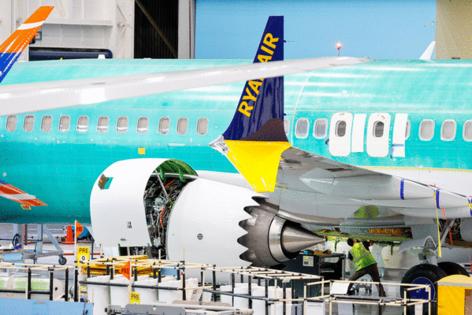FAA allows Boeing to help certify 737 Max and 787 planes are safe to fly
Published in Business News
The Federal Aviation Administration will once again allow Boeing employees to help certify that the company’s planes are safe to fly.
The FAA revoked that authority for Boeing’s 737 Max in 2019, after two fatal crashes caused by faulty software on the then-new plane, and for Boeing’s 787 Dreamliner in 2022, because of production quality issues.
On Friday, the FAA said it would “allow limited delegation to Boeing” to issue airworthiness certificates on some 737s and 787s. Starting Monday, Boeing and the FAA will issue the airworthiness certificates on alternate weeks.
The regulator said it had thoroughly reviewed Boeing’s production process and would continue to maintain “direct and rigorous oversight” of the aerospace manufacturer.
“Safety drives everything we do, and the FAA will only allow this step forward because we are confident it can be done safely,” the regulator said in a statement.
Boeing’s authority to help the FAA with some tasks, like certifying that planes are safe to fly, comes from a program called Organization Designation Authorization, or ODA.
The program, which has been in place at Boeing since 2005, is meant to help the FAA maintain oversight with limited staff and resources. It allows some Boeing employees, called unit members, to work on behalf of the FAA, certifying inspections, repairs and other tasks in the factory.
The FAA renewed Boeing’s Organization Designation Authorization, for tasks other than the airworthiness certificates, in May for another three years.
The ODA program has been heavily scrutinized for the amount of oversight it gives Boeing. ODA unit members have for years alleged they felt pressured by their Boeing counterparts to move quickly and approve tasks in order to meet schedules and delivery deadlines.
This month, the FAA fined Boeing $3.1 million for quality system violations and allegations of “undue pressure” on ODA unit members. The fine focused on actions from September 2023 to February 2024, the months leading up to and directly after a panel blowout on an Alaska Airlines flight from Portland, Oregon.
The FAA found that a Boeing employee who was not involved in the ODA program pressured an ODA worker to sign off on a 737 Max airplane so Boeing could meet its delivery schedule, even though the ODA worker had determined the aircraft did not comply with standards.
Boeing has spent the months since the panel blowout designing and implementing a safety and quality plan and said earlier this year it is seeing improvements to its oversight program, according to the company’s annual safety briefing, released in May.
It hired an ombudsperson to act as a neutral third party to address employee concerns, added more employees who could perform tasks on behalf of the FAA and improved its “pipeline” to address retirements.
Boeing didn’t respond immediately to a request for comment Friday.
The FAA said Friday it would continue to observe Boeing’s safety culture and ensure that the company’s employees feel they can report concerns without fear of retaliation.
The regulator said that renewing Boeing’s ability to certify airworthiness for its planes will allow FAA inspectors to survey other parts of the production process, like “critical assembly stages,” and take a high-level view at trends within the company.
The FAA still caps Boeing’s 737 Max production at 38 planes per month, a threshold put in place after the panel blowout to ensure the company is focused on quality and safety in its manufacturing processes. Boeing executives have said they are preparing to ask the FAA to lift the cap in the coming months.
©2025 The Seattle Times. Visit seattletimes.com. Distributed by Tribune Content Agency, LLC.












Comments